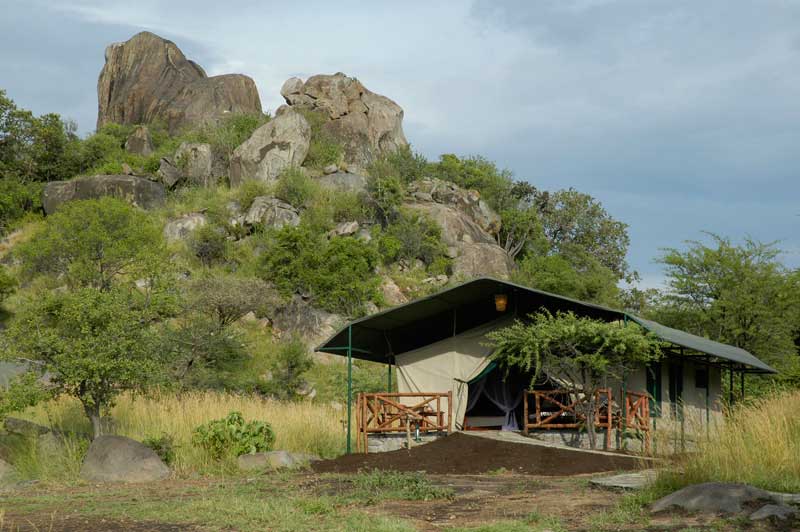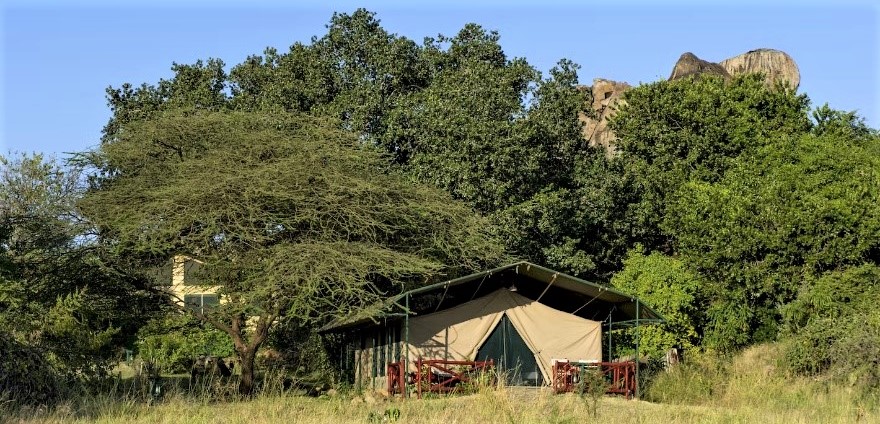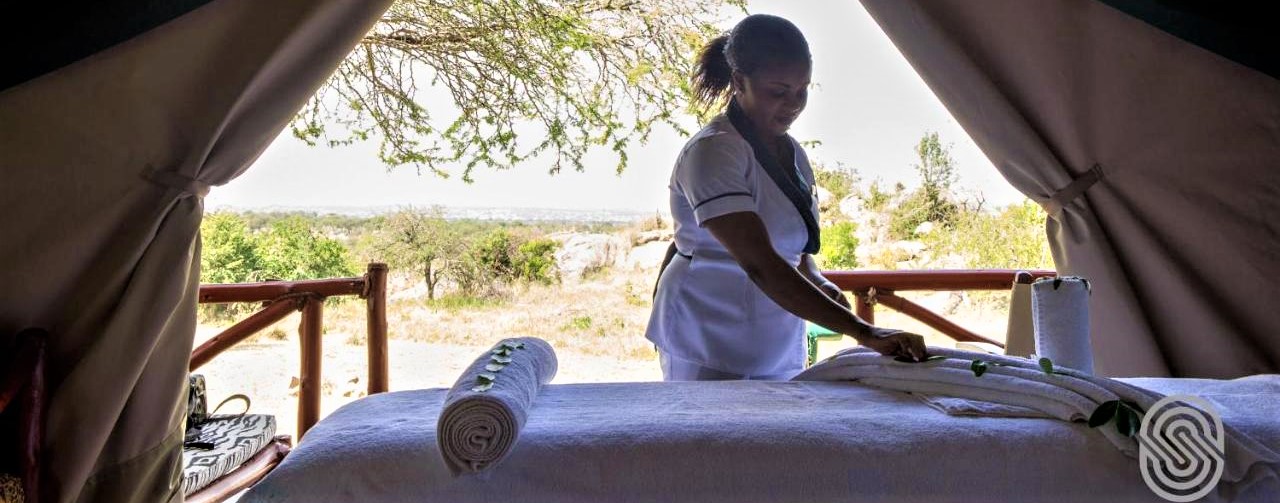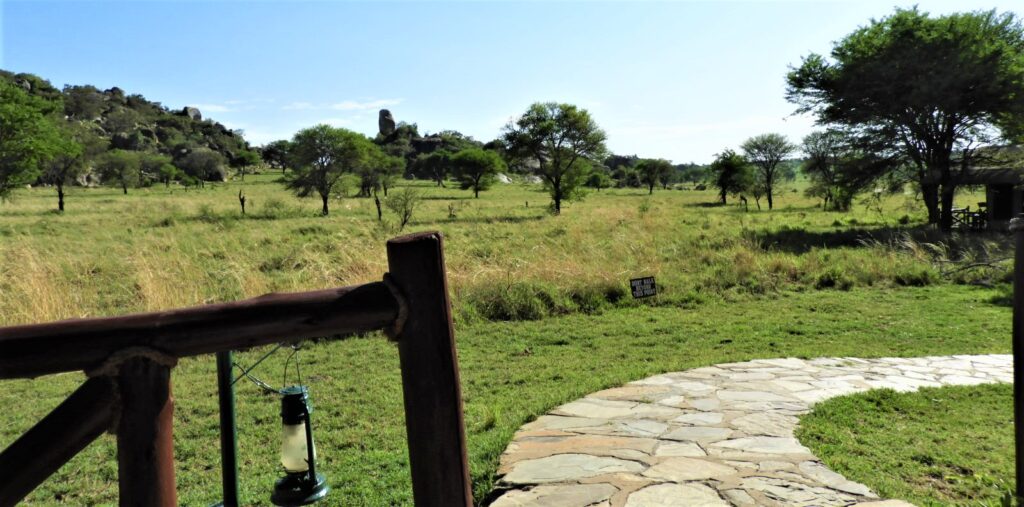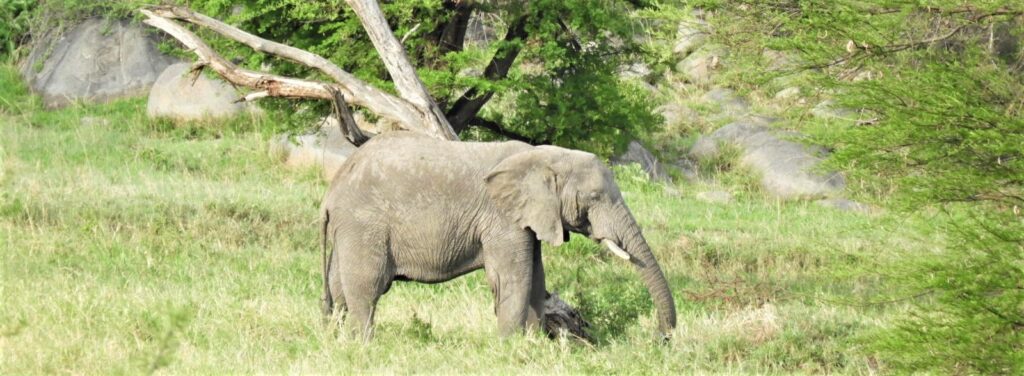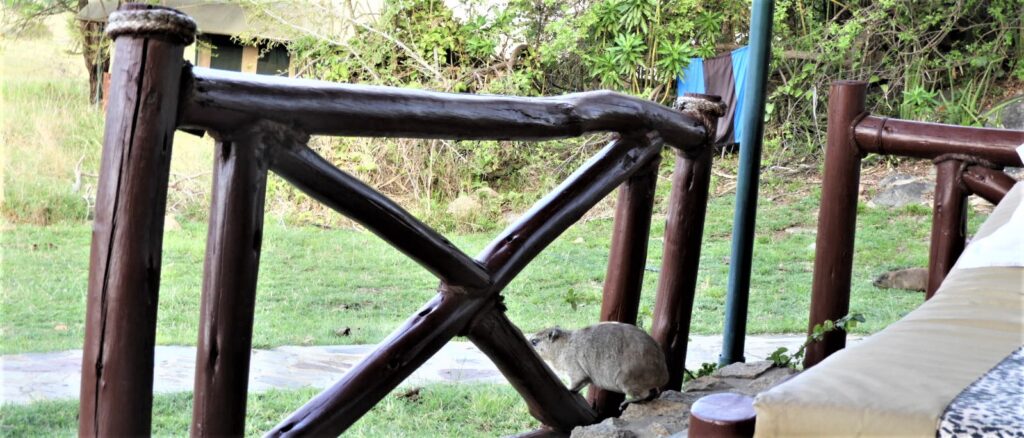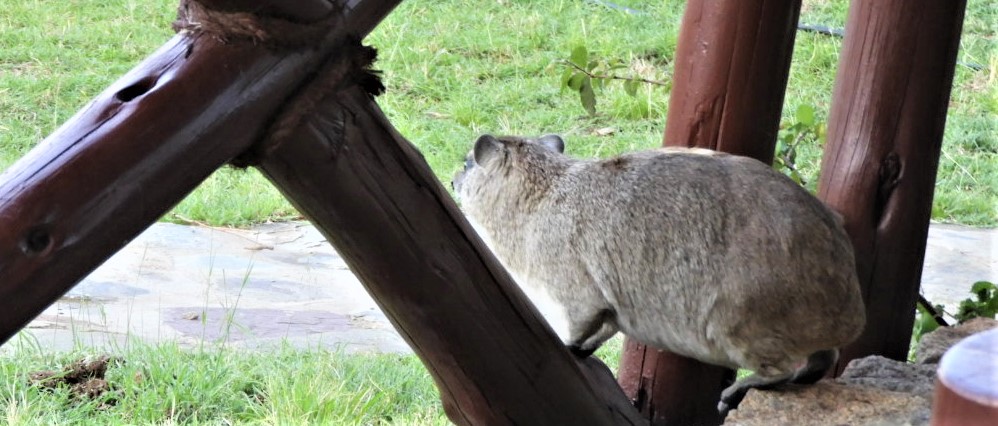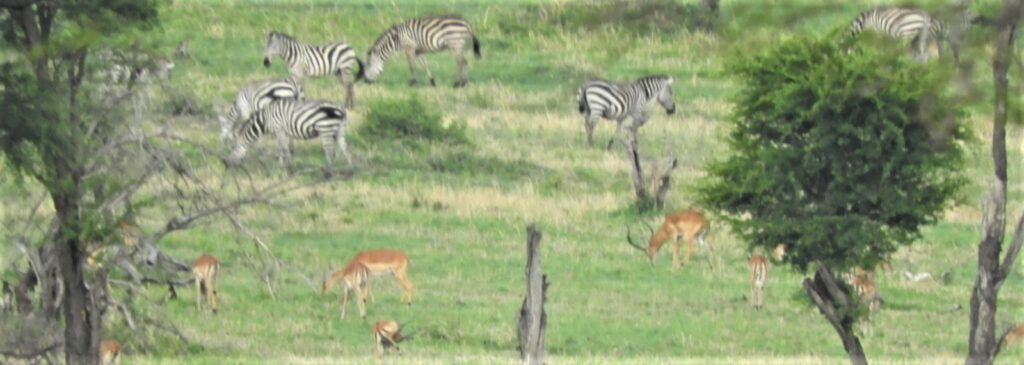Archive for September 23rd, 2022
» posted on Friday, September 23rd, 2022 by Linda Lou Burton
You’ll Never Guess
Linda Lou Burton posting from Mbuzi Mawe Serena Tented Camp, Serengeti National Park, Tanzania–Now I know about kopjes. Big rocks, jutting up in the wide-open savannah. Big rocks where lions like to nap. So I’m thinking – just how safe is my tent, really? It’s just canvas, with a zippered flap. And those kopjes aren’t only in front of my tent, they are behind it too; in fact, Mbuzi Mawe Serena Tented Camp is clustered around the base of some rather marvelous looking kopjes. A very, very long way from the Walmart, or, well, anything. Here’s an aerial view of the camp – buildings snuggled against kopjes, and then, savannah. I’m pretty sure our tent is in the middle, snuggled in the trees just right of the triangle sidewalks and facing the grasses; the large lounge and dining tents are left of the triangle.
Here’s what they say about themselves: Discover a refined retreat within the natural beauty of Serengeti National Park. Mbuzi Mawe Serena Camp’s 16 canvas tents offer spacious style and home-like comforts. Reachable by a winding stone path, our tents are dotted through the rocky glades of the camp; they stand on a stone platform. The expansive main bedroom has two queen beds, covered by mosquito nets. A seating area offers comfortable chairs and stylish lamps; unwind and read a book. The bathroom opens off the bedroom and includes a flushing WC, twin basins, and a shower with 24-hour hot water. Each tent has a private outdoor terrace with safari chairs and sun loungers; have a seat and admire the panoramic views. Tucked within the center of Mbuzi Mawe Serena Camp, our tented dining room offers a welcoming atmosphere, as well as an expansive terrace with sweeping views of the plains. Located within the camp’s central lounge area, our stylish bar is a welcome spot for a cocktail with friends after a successful day on safari.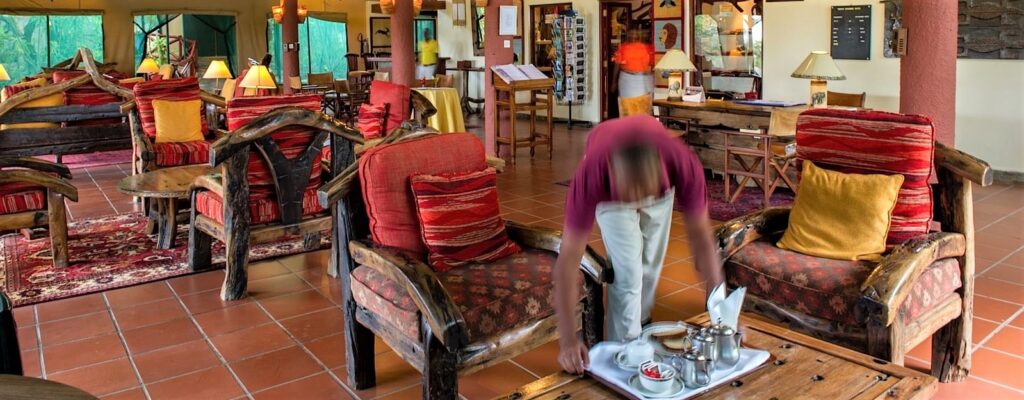
I have found the above to be basically true, although one detail is omitted – we are not to wander around after dark unaccompanied! Be inside our tent, flap zipped, after dark. Call security for an escort if we want to walk around. Yes, we have a phone in our tent. We’re to call for security, or room service, anytime we feel uneasy, or hungry. A big difference in this tented camp and our first two, as well as all the Lodges – they were FENCED IN. Although we were staying inside the Parks, the Park’s animals couldn’t roam around our tents/rooms. Until here. Have we seen a lion lurking? Well, not yet.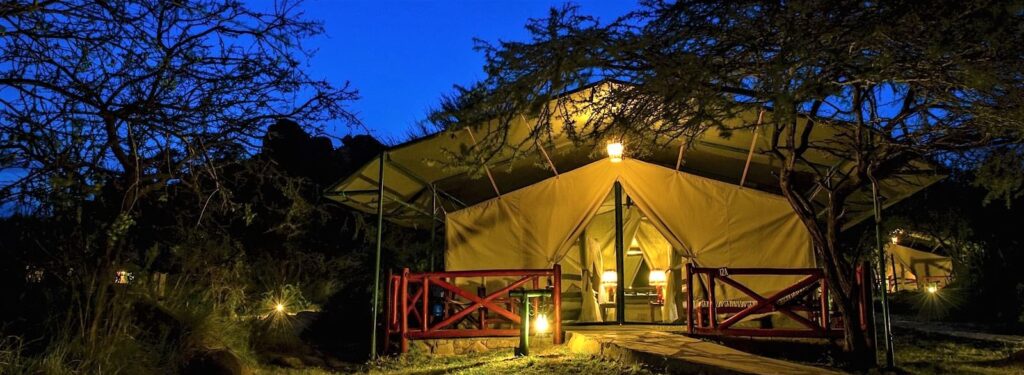
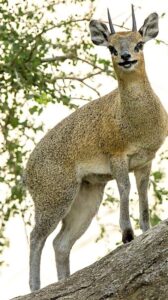 My curious self wanted to know more about this particular camp. What does Mbuzi Mawe mean? You’ll never guess, unless you’ve been studying your Swahili/Afrikaans/Dutch. Mbuzi Mawe translates to “klipspringer.” Which means: rock jumper, which is a very small antelope that lives on kopjes (also a Swahili/Afrikaans/Dutch word). Have I seen any klipspringer’s today, as I gazed at my kopjes? Well, not yet. These little fellows are tiny – less than two feet tall at the shoulder, weighing less than 40 pounds. Their yellowish-gray coat is great camouflage, and (like the lions) they mostly sleep during the day. I wish I’d seen them, or could tonight – it’s said the romantically inclined monogamous critters like to
My curious self wanted to know more about this particular camp. What does Mbuzi Mawe mean? You’ll never guess, unless you’ve been studying your Swahili/Afrikaans/Dutch. Mbuzi Mawe translates to “klipspringer.” Which means: rock jumper, which is a very small antelope that lives on kopjes (also a Swahili/Afrikaans/Dutch word). Have I seen any klipspringer’s today, as I gazed at my kopjes? Well, not yet. These little fellows are tiny – less than two feet tall at the shoulder, weighing less than 40 pounds. Their yellowish-gray coat is great camouflage, and (like the lions) they mostly sleep during the day. I wish I’d seen them, or could tonight – it’s said the romantically inclined monogamous critters like to 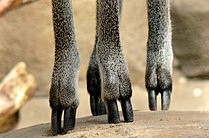 dance on the rocks in the moonlight. Imagine that, with their tiny odd hooves, Designed by Nature for ease of rock climbing. And yes, I said monogamous. Dad looks after Mom, and the kids. Something’s working for the klipspringer’s way of life: they are classified Least Concern by the IUCN with no major threats to their survival.
dance on the rocks in the moonlight. Imagine that, with their tiny odd hooves, Designed by Nature for ease of rock climbing. And yes, I said monogamous. Dad looks after Mom, and the kids. Something’s working for the klipspringer’s way of life: they are classified Least Concern by the IUCN with no major threats to their survival.
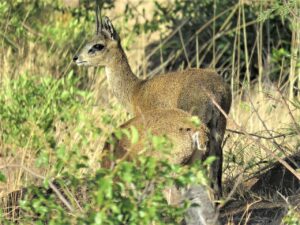 Note how they feed – one on lookout while the other eats. They’re so pretty, they almost look like painted dolls. Mbuzi Mawe! More pictures below (not mine) of the Mbuzi Mwae Tented Camp and the kopjes where both lions and klipspringers hang out.
Note how they feed – one on lookout while the other eats. They’re so pretty, they almost look like painted dolls. Mbuzi Mawe! More pictures below (not mine) of the Mbuzi Mwae Tented Camp and the kopjes where both lions and klipspringers hang out. 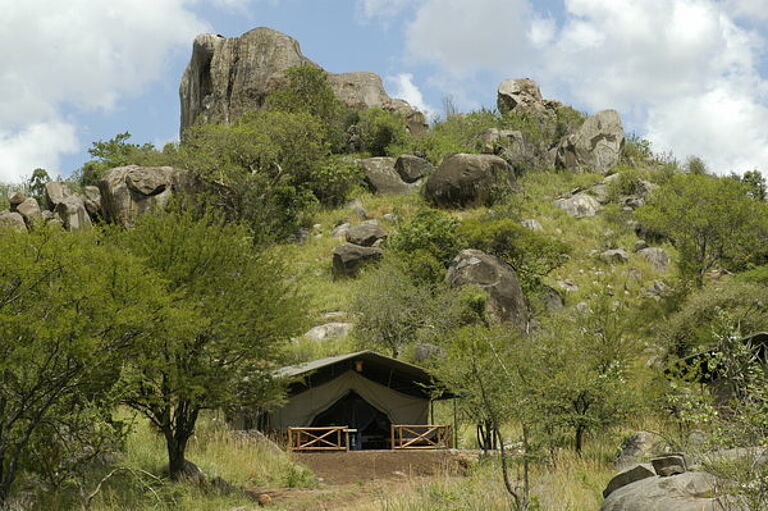
The above is our tent, note the yellow dining/lounge tent through the trees. Least walking!
Memories of my morning massage, as good as the kopjes for taking a nap.
Mbuzi Mawe Serena Tented Camp https://www.serenahotels.com/mbuzi-mawe
Serengeti National Park https://www.serengeti.com/
Next Post: Let Sleeping Lions
» posted on Friday, September 23rd, 2022 by Linda Lou Burton
There’s An Elephant In My Yard
Linda Lou Burton posting from Mbuzi Mawe Serena Tented Camp, Serengeti National Park, Tanzania–There’s an elephant in my yard. That’s one thing I never expected to say. Live long enough and things you never knew you’d enjoy just show up. It happened today. I sat on my lovely little tent porch and watched an elephant grazing in my front yard. By the end of the afternoon, I’d also watched buffalo, zebra, antelope, and an orange-shirted jogger out there between me and the kopjes. The hyraxes scampered around my porch while this was going on. Who needs to go on a game drive looking for animals!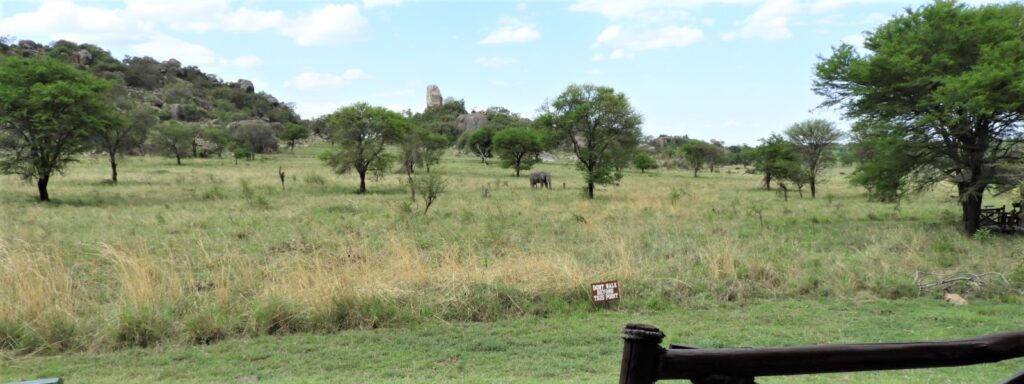
 I was practically catatonic this morning when the gang headed for the 4x4s and a full day on the Serengeti. Rick promised to share his photos with me, so I slept. And slept. New Star, the lovely lady who had welcomed me in yesterday, brought me tea and breakfast, inquiring about my welfare (I suppose she’d been consigned to do so). She also offered her services for a massage, and we agreed on a time. Now, between a massage, a grassy lawn, and a slow munching elephant, a person is about as relaxed as a person can ever hope to be. So, totally relaxed, I give you your lessons for the day – about elephants, and kopjes.
I was practically catatonic this morning when the gang headed for the 4x4s and a full day on the Serengeti. Rick promised to share his photos with me, so I slept. And slept. New Star, the lovely lady who had welcomed me in yesterday, brought me tea and breakfast, inquiring about my welfare (I suppose she’d been consigned to do so). She also offered her services for a massage, and we agreed on a time. Now, between a massage, a grassy lawn, and a slow munching elephant, a person is about as relaxed as a person can ever hope to be. So, totally relaxed, I give you your lessons for the day – about elephants, and kopjes.
My elephant today – I named him Fred – was a young male. Males leave their family groups when they reach puberty and live alone, or with other males, interacting with female family groups only when looking for a mate. Fred didn’t appear to be looking for anything today other than the next bite of grass; he was relaxed, contented, and unbothered (like me). Fred was a nice elephant! He was the first young male I’d spotted; I’d seen the matriarchal family units at Ol Pejeta, Maasai Mara, and Amboseli, either a female with her calves or several related females with offspring. The girls stick together, kicking the male calves out around the age of three. Some elephant factoids:
- Elephants are the largest existing land animals and can live up to 70 years.
- Elephant species existing today are the African bush, the African forest, and the Asian.
- Elephant trunks are used for breathing, bringing food and water to their mouth, and grasping things.
- Elephant tusks are used as weapons, and as tools for moving things and digging.
- Elephants communicate by touch, sight, smell, and sound, using infrasound and seismic communication over long distances.
- Elephants have self-awareness and appear to show empathy for dying and dead family members.
I already knew most of that about elephants, but I had never heard of kopjes (hoping my geology professor isn’t reading this, maybe I forgot!). Kopjes (pronounced KOP EES), are the rock formations making the backdrop for Fred across my grassy yard this afternoon. Massive rocks! Ancient rocks! They originally formed and cooled under the surface of the earth from volcanic activity; over millions of years the surrounding softer rocks eroded, leaving these incredible, beautiful “mountain islands.” Gneiss.
Why do lions, and leopards, hang out on the kopjes? What is nicer than a warm rock for a nap? Or what better vantage point for spotting dinner? A few more things make kopjes an interesting (and unique) environment.
- Water: hollows and cracks in the rocks store water for a long time, so mammals, birds, and plants can survive even if it’s completely dry all around.
- Plants: kopjes protect certain plants from mega-herbivores such as elephants and giraffe who can’t climb there; kopjes also protect plants from fires on the savannah.
- Nutrients: leaf litter and animal dung collect in the cracks of kopjes; lions and eagles bring their prey to the kopjes; all resulting in a flow of nutrients on a grand scale.
Pretty cool, these kopjes. But one thing I can’t puzzle out: it makes sense that my little rock hyraxes (I named them Ethel and Lucy) thrive on the kopjes and scamper every which way all day long. But why, I wondered, were the zebras, antelope, and even buffalo grazing peacefully beneath the kopjes this afternoon, possibly within view of a hungry lion? And why young Fred? And lord help us, why the orange-shirted jogger! See all below.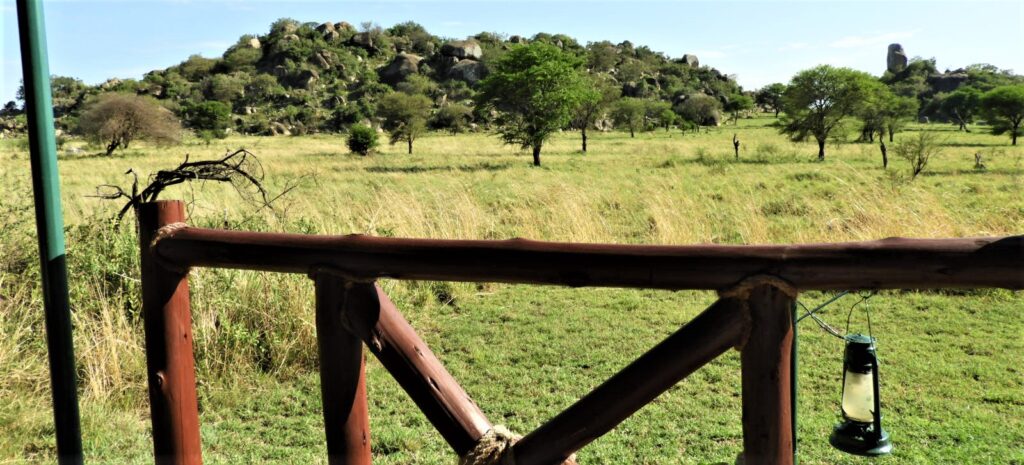
PS I tried my darndest to spot a tusk or flat nails on the hyraxes today, and even asked them if they were related to Fred, but they refused to comment. Be sure to note Lucy on top of the tent pole above my lounge chair. Ethel preferred to hang out on the bottom rail, watching Fred perhaps? Wondering?
Mbuzi Mawe Serena Tented Camp https://www.serenahotels.com/mbuzi-mawe
Serengeti National Park https://www.serengeti.com/
Next Post: You’ll Never Guess


